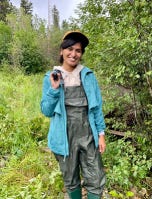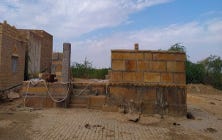Role of social networks in adapting to climate change: insights from rural desert communities of India
Shreya Ojha, Kansas State University
Keywords: Social networks, Rural desert communities, Water, Climate adaptation
In the last two decades, rural communities have been regarded as ‘objects’ of development research; but they are now increasingly being recognized as ‘subjects’ in action-based research, particularly when their knowledge is utilized for perception studies. As the trend of policymaking and governance is shifting towards community-driven measures to adapt to climate change; context-specific responses in addressing climate change adaptation and vulnerability have gained popularity. This blog brings insights on how rural desert communities of India are leveraging ‘sense of community’ and ‘belongingness’ to thrive climate change.
Thar, the Great Indian desert, is a highly sensitive and fragile ecosystem. Droughts, desertification, land degradation, groundwater salinity, and above all, scarcity of water are permanent characteristics of this region. Through primary survey, in four villages (Amar Sagar, Deva, Ramdevri and Baramsaar,) it was observed that majority of the population is engaged in agriculture and animal rearing. The predominant agricultural practice in this region is traditional dryland farming with heavy reliance on rainwater and traditional methods of water harvesting and conservation. Farmers in this region perceived climate change to be real and reported that it has negatively affected their crop health, yield, harvest, and livestock. Livelihoods of rural desert communities in India is closely tied to the natural environment rendering them vulnerable to environmental shocks. With only 3.5 – 7 inches of annual rainfall (in a good year) this region screams of environmental challenges, the rural desert communities have managed to build strong social networks to leverage their traditional knowledge, close connections, and collective efforts to adapt in this harsh environment.

To attend to the water needs of 1.26 million people from 568 villages in this region, the State’s Public Health, and Engineering Department (PHED) built solar and diesel-powered water pumps to store water in Ground Level Reservoirs. Additionally, pipelines have been constructed by excavating rocks buried beneath the sand. However, reports and primary survey results state that this water contains elevated levels of fluoride and salinity and is non-potable. The recent report by Central Ground Water Board (Government of India) and Ground Water Department (Government of Rajasthan) states indiscriminate overextraction of groundwater (16.74 billion cubic meters, ~148.77%) in 216 out of the 302 groundwater extraction units has placed this region in the ‘overexploited’ groundwater category (CGWB, 2024). Scanty rainfall, depleting water tables, and effects of climate change add to the challenge of groundwater replenishment. The PHED has recently announced a shift from groundwater-based schemes to surface water-based schemes to tend to the water needs.
By social networks, I refer to: (i) sharing resources, collective savings, and information for natural and financial resource utilization; (ii) emotional and material support from social ties; and (iii) informal financial interactions (lending and borrowing money, to and from immediate family, relatives, friends, or neighbors).

Social networks in access to water:
In terms of access to water, the surveyed rural desert communities rely on traditional methods of water harvesting and conservation. A notable 13.8% of the population relies on open water (oases or ‘beris’ and open wells) which are traditional percolation tanks that are recharged overnight, necessitating multiple trips to collect water. Women and girls play a key role in collecting water and walk at least 1.5 miles (average distance) every day to the nearest water source with 30.5% of them travelling more than an hour (~4 miles to and fro). A 75-year-old male respondent reported “I have seen my mother, my wife and now my daughters-in-law go through the trouble of walking long distances in search of water..nothing has changed.” Collecting water often requires multiple trips at various times of the day in extreme weather like sandstorms, excessive heat/cold.
Only 16.6% of the households have access to piped water and the salt content in this water makes it unsuitable for drinking. Similarly, 8% water that is provided through the Indira Gandhi Canal to Ramdevri and Pokhran villages is not potable due to high salinity. Approximately 41.6% of the community relies on stored rainwater, water wells, beris and traditional methods of water harvesting and conservation for drinking, while tap water is primarily used for domestic purposes. About 91.6% of the households save up to 5.2 – 10.5 gallons of water per day for a family of 6; 30.5% of the respondents’ conserve less than 5.2 gallons per day. Drinking water is also delivered through ‘tankers’ or water delivery trucks and the information about their arrival is disseminated through friends, relatives and fellow-farmers. Additionally, strong relationships between the rural community and the tanker drivers facilitate effective information exchange for access to water.
Social networks in access to financial resources:
According to research, institutional access to financial resources allows communities to be better prepared to save water in advance, adjust farming practices, diversify their channels of income based on the changes in climate and makes communities less vulnerable to climate related shocks. Access to formal institutions for credit, insurance, loans, advisory services on crop and livestock production, subsidized farm implements, water-saving technologies, farmer training and weather information play an important role in determining the adaptive capacity and resilience of farming and herding communities.
Based on survey results it was found that households have primarily resorted to informal means of borrowing and lending money, eschewing formal banking credit and loan facilities. Even though 63% of the respondents owned bank accounts, they did not utilize them. High interest rates, lack of collateral, inability to pay back loans, large upfront costs required to improve post-harvest crop value through value addition and the general attitude of formal financial institutions to work in favor of large land holding farmers and those with insider connections in the banks, local government are some of the barriers rural communities face in accessing formal financial institutions. Rural communities have resorted to borrowing and receiving assistance amongst themselves instead of approaching the local government. Connections are built on the principles of trust, sharing, and helping each other in time of need. They prefer relying on their immediate relatives or friends for financial assistance. Connections are built on the principles of trust, sharing, and helping each other in time of need.
While shared experiences, strong networks and collective decision making provide the essential support to the rural community and aid in navigating the challenges of the harsh environment, they also highlight the systemic and structural vulnerabilities. Reliance on external sources for drinkable quality water at premium rates; making major adjustments in lifestyle to conserve water and hesitance in accessing formal financial institutions adds to the financial, livelihood and climate induced stress of the vulnerable rural desert communities of India.
References:
Rajasthan, G. D. (2013). Hydrogeological Atlas of Rajasthan, Jaisalmer District. Jaisalmer: Groundwater Department Rajasthan, European Union State Partnership Programme. https://phedwater.rajasthan.gov.in/content/dam/doitassets/water/Ground%20Water/Pdf/PublicReports/Groundwater_Atlas/Districts/Districtwise%20Atlas%20-%20Jaisalmer.pdf
— Shreya Ojha
Author’s Bio

Connect with us at:
Thanks for reading Just Rural Futures! Subscribe for free to receive new posts and support my work.






Very informative and interesting peak into their life! And here we take water for granted..
Good information. Hopefully digital India will transform lives of many such communities.